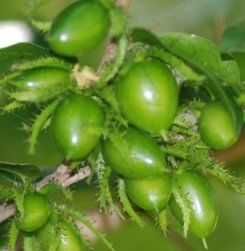Dovyalis rhamnoides
Dovyalis rhamnoides ( Burch. ex DC.) Burch. & Harv
Family: Salicaceae
Common names: common sourberry (Eng.); gewone suurbessie (Afr.); ukhamgwindi (Zulu); umqaqoba (Xhosa)
Introduction
This is a spiny, evergreen shrub or tree bearing edible fruit. It is easily cultivated and attracts birds to the garden.

Description
Description
Dovyalis rhamnoides is an evergreen shrub or a small tree 1-7 m high. It has grey brown bark and is well known for the spines on the stem and close by the leaves. The plant is hairy when still young but leaves are glabrous or shiny later. Leaves are simple and oval shaped.

The flowers are tiny creamy green and male and female flowers odccur on different trees i.e. the plants are dioecious. Male flowers are more attractive displaying many stamens.


Female trees bear red oval berry fruits which are relished by birds. Unripe fruits are a shiny green before they ripen. Fruits are not produced each year. does not produce fruit every year.
Conservation Status
Status
The plant is currently listed as Least Concern (LC) against the I.U.C.N criteria in Red List of South African plants (Raimondo et al. 2009). It is not threatened in the veld although it has some economical value. But in-situ conservation is needed for research purposes and monitoring of this species is recommended.
Distribution and habitat
Distribution description
The species is widely distributed in KwaZulu-Natal (KZN), but it can also be found in Limpopo, Mpumalanga, Swaziland and Western Cape. It grows in a well-drained soil in bushveld and on forest margins or in riverine environment.
Derivation of name and historical aspects
History
Dovyalis has been derived from the Greek word meaning spear. The specific name rhamnoides means `like Rhamnus ', a Greek name referring to various spiny shrubs. This species was first recorded by Burchell. Other species in this genus include D. caffra , D. zeyheri , D. lucida and D. longispina.

Uses
Use
The plant can be used as a hedge or can be planted as a tree. Its fruits are edible and very delicious. They can also be used to make jam, jelly preserve, vinegar and brandy. It attracts insects because of its fruits. It also makes a good nesting site for some bird species as it has thorns that can help to protect the bird from threats. Its stem can be used as timber for craft work and agricultural implements. There is also evidence of it being used for medicinal purpose although its use is very limited.
Growing Dovyalis rhamnoides
Grow
The plant easily propagates from seeds during October to February but it can also be propagated from cuttings while the stem is still soft. It grows in a sunny or a semi-shaded environment.
References
- Coates Palgrave, M. 2002. Keith Coates Palgrave Trees of southern Africa, edn 3. Struik, Cape Town.
- Glen, H.F. 2004. SAPPI What's in a name? The meaning of the botanical names of trees. Jacana, Johannesburg.
- Pooley, E. 1997. The complete field guide to trees of Natal, Zululand and Transkei . Natal Flora Publications Trust, Durban.
- Raimondo, D., Von Staden, L., Foden, W., Victor, J.E., Helme, N.A., Turner, R.C., Kamundi, D.A. & Manyama, P.A. (eds) 2009. Red List of South African plants. Strelitzia 25. South African National Biodiversity Institute, Pretoria.
- Van Wyk, Braam [A.E] & Van Wyk, P.1997. Field guide to trees of southern Africa. Struik, Cape Town.
Credits
Azwindini Mudau and Katlego Selemela
With images by Andrew Hankey
Walter Sisulu National Botanical Garden
October 2012
Plant Attributes:
Plant Type: Shrub, Tree
SA Distribution: Eastern Cape, KwaZulu-Natal, Limpopo, Mpumalanga, Western Cape
Soil type: Sandy, Loam
Flowering season:
PH: Acid, Neutral
Flower colour: Green, Cream
Aspect: Full Sun
Gardening skill: Average
Special Features:
Horticultural zones










Rate this article
Article well written and informative
Rate this plant
Is this an interesting plant?
Login to add your Comment
Back to topNot registered yet? Click here to register.